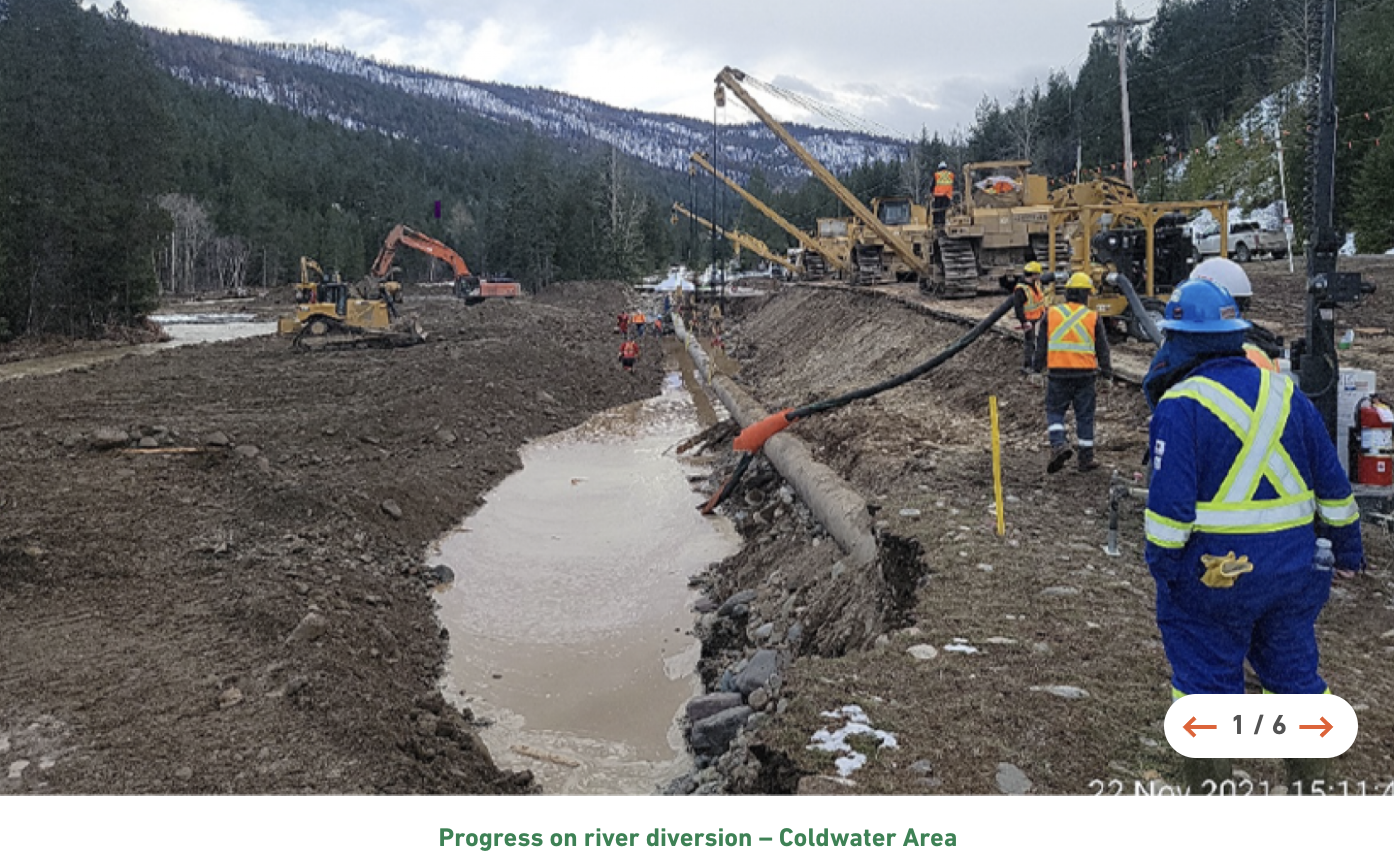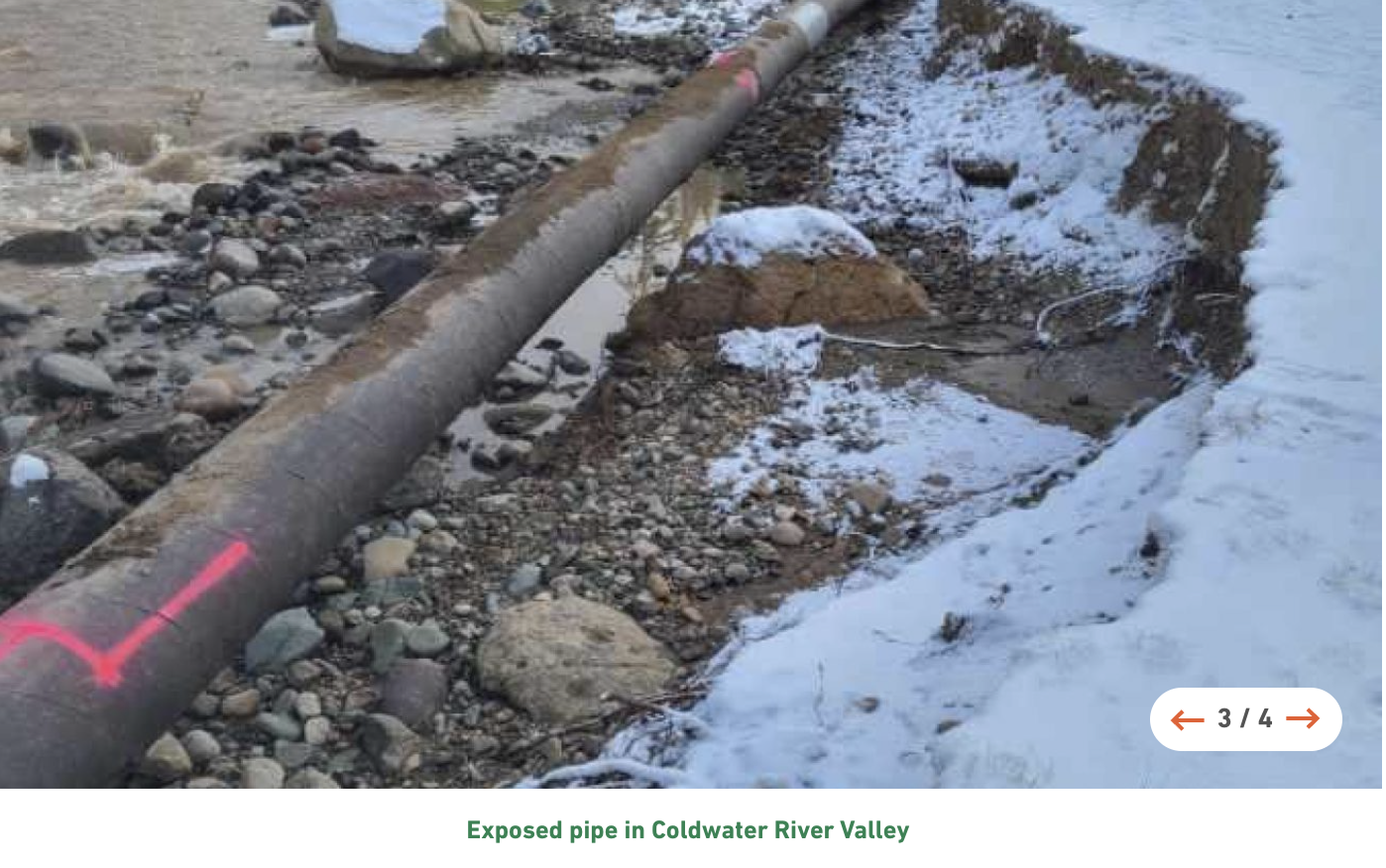
Hope for a huge, ancient and imperilled fish
First Nations are leading efforts to make sure lake sturgeon can find a home in...
Flooding from torrential rains in B.C. have left sections of the Trans Mountain pipeline exposed along river banks and raised questions about the ability of the project to withstand extreme weather events.
Pictures posted by Trans Mountain show previously buried portions of the existing pipeline exposed or under water along the Coldwater River in central B.C.
Trans Mountain said there have not been any oil leaks due to the flooding, which has triggered an emergency shutdown of the pipeline lasting longer than any previous stoppage in its nearly 70-year-history. The newly-exposed sections of the line are now vulnerable to continued flood water and debris, according to an independent pipeline engineer who spoke to The Narwhal.
The company, which is owned by the Canadian government, said work to divert the flooded waters back to the river along the pipeline route is nearly complete but declined to share any details about its own evaluation of the risk.
The emergency shutdown follows a series of incidents on the aging pipeline’s network, including a June 2020 breakdown at a pump station in Abbotsford — an area hit hard by the torrential rains.
Some 190,000 litres of crude oil was spilled in and around the Abbotsford pump station during the incident, and not all of it was recovered. Trans Mountain agreed to upgrade the facility, following a federal investigation, but declined to say whether those upgrades were completed in the summer of 2021 as anticipated. It is also unclear whether any of the remaining contamination was swept away by the raging floods that have devastated many homes and businesses in Abbotsford.
But the Transportation Safety Board, in its investigation of the spill released in April, noted that the oil cleanup was expected to take years.
The federal agency also found company contractors violated safety rules in 2015 by improperly installing fittings and failing to adequately inspect the shoddy work which led to the spill. The board also reported that Trans Mountain took five hours to manually shut down the leaking valve. By that time, the company’s containment system could not hold back the flow and oil spilled into a nearby field.
The board directed questions to the energy regulator, but neither the company, nor the regulator, responded to a request to confirm what work was completed.
Meanwhile, more rain is expected to fall this weekend.

Abbotsford is about 200 kilometres west of the section of the pipeline in central B.C. that has been exposed.
On its website, the company said on Tuesday that it has deployed spill-response equipment and containment booms in some areas as a precaution to the extreme weather.
It also said crews are almost finished with ground evaluations of the pipeline in the Coquihalla and Coldwater regions in an attempt to restart the line after it was voluntarily shut down on Nov. 14 in preparation for the heavy rains.
The company said on the site that it hopes to restart operations “in some capacity” by the end of the week.
The company did not respond when asked by The Narwhal whether it would consider route changes or changes to its current plans for the expansion of the pipeline, in light of the impacts from the floods.
The Canada Energy Regulator, which oversees the pipeline, said there have been no spills triggered by the floods from Trans Mountain or any other pipeline under its jurisdiction, and that it continues to work with companies to monitor flood-impacted infrastructure. It added some companies have reported exposed pipelines and voluntary shut downs but did not provide details.
“We currently have [energy regulator] inspectors on the ground in areas affected by flooding and are gathering information to ensure a safe return to service,” regulator spokesperson Lisa LeBel said in a statement.
“We will not allow any [Canada Energy Regulator]-regulated pipeline to restart unless it is safe to do so.”
Don Deaver is an engineer based in Texas who provides expert witness testimony and consulting services for pipeline operations and maintenance.
He told The Narwhal in an interview that pipelines can face stress in waterways and need to remain buried in order to maintain stability, but also to add a layer of protection against trees, rocks and other debris.
“Those rocks,” he said, after looking at a photo of an exposed section of the Trans Mountain pipeline, “if the velocities are great enough, can be picked up and it kind of depends upon the density of the rock itself, but they can be picked up and then they can be dropped.”

“And they can rub over a pipeline that’s exposed, that’s why a pipeline, even during flood stage, has to be protected … you know, trees can be moving down at 10 to 15 feet per second — that’s quite a bit, there’s a lot of momentum there and it hits it.”
Ron Wong, a professor of civil engineering at the University of Calgary, said there are a lot of factors in considering the integrity of a pipeline. He said the movement of soil around the pipe is the most important.
“Any pipe engineer, when they carry out what they call the risk assessment, they will pick the route they want,” he explained.
Wong said that includes avoiding areas with a lot of potential ground movement, particularly from things like landslides.
He said exposed pipelines, even with the ground beneath them washed out, can support their own weight, depending on the length of the exposed section. The photos posted to the Trans Mountain site do not appear to reflect significant structural problems for those sections, according to Wong.
Trans Mountain has faced scrutiny and reprimand from the regulator over the course of the expansion project and raised concerns over safety and environmental protection at several sites.
On Oct. 9 last year, the federal regulator sent a written warning letter over a 2019 incident that the regulator said demonstrated a “wilful disregard of safe activities near the pipeline” by one of Trans Mountain’s employees after a backhoe damaged the pipeline.
At the beginning of June, the regulator imposed a stop-work order on the entire expansion project that restricted clearing and mowing along the route, but allowed other activities to continue, after it was discovered crews were cutting down trees in migratory bird habitats. That order was lifted almost three weeks later.
Earlier this month, a regulator inspection at a Trans Mountain site in Surrey, B.C., found inadequate erosion and sediment control measures were in place to protect a wetland and two fish-bearing waterways, despite the company pledging to implement the measures prior to construction, following an earlier inspection of the site.
Cam Fenton, an organizer with environmental group 350.org, said the latest impacts of extreme weather on the existing pipeline could be a warning about whether Canada should go ahead with expanding the Trans Mountain network.
“From these floods, and then you go back through this year, [the Trans Mountain expansion] has been impacted or delayed now by extreme rains, flooding, extreme heat and wildfires,” he said.
“If you wanted a better sign to sort of raise the question as to whether or not we should be building a new fossil-fuel project during the climate crisis, I don’t think you could really come up with one.”
Get the inside scoop on The Narwhal’s environment and climate reporting by signing up for our free newsletter. Angello Johnson’s shoulders burn, and his arms...
Continue reading
First Nations are leading efforts to make sure lake sturgeon can find a home in...

We’re excited to share that an investigation by The Narwhal is a finalist for the...

A new documentary, Nechako: It Will Be a Big River Again, dives into how two...
